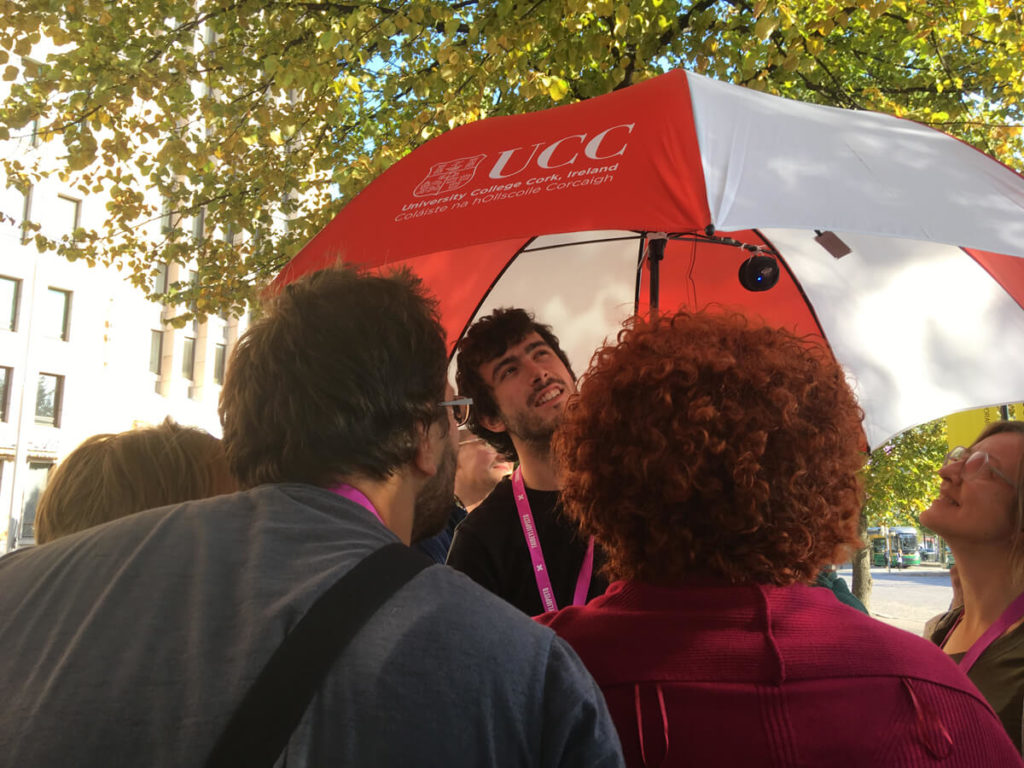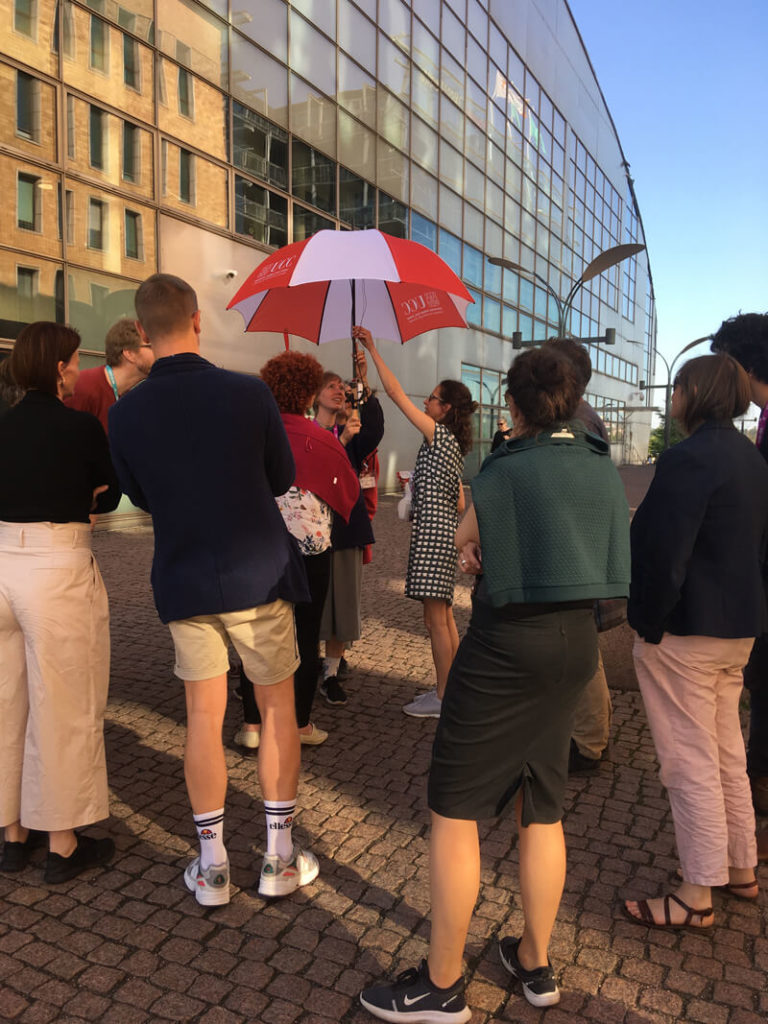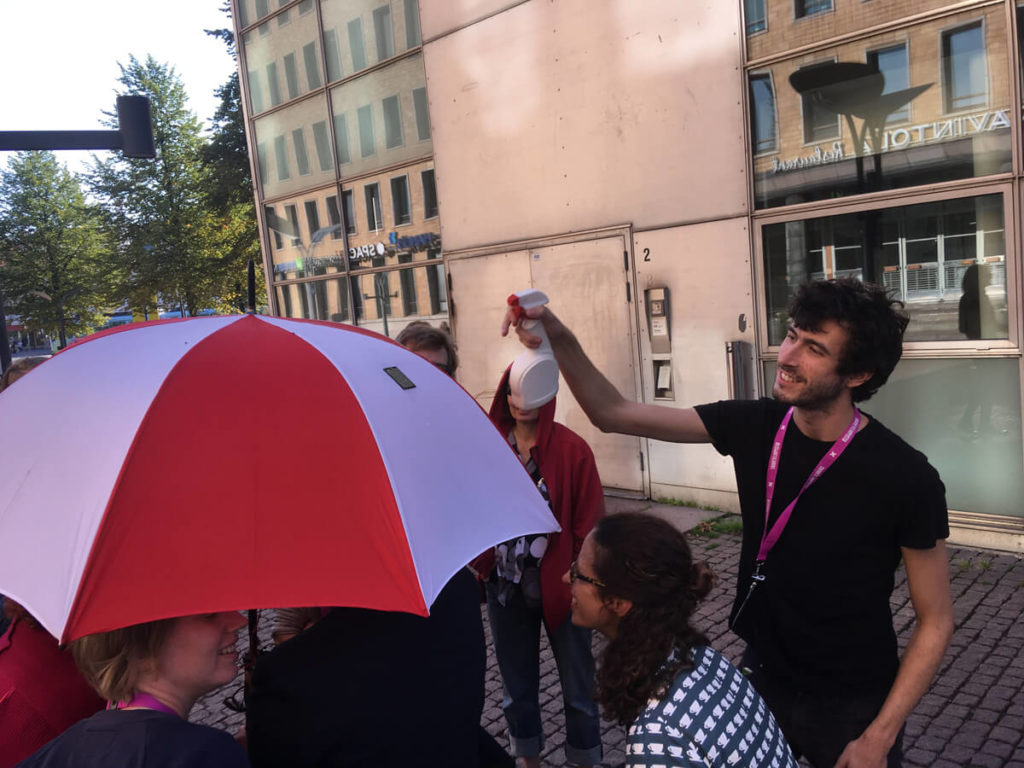Abstract
This presentation focussed on the trans-disciplinary Artistic Research project Drench, whose iterations include a creative radio feature and a public art installation. Writer and performer Jools Gilson and composer Sebastian Adams developed the experimental radio documentary The Rain Box in 2017 for Lyric FM in Ireland. The Rain Box was nominated for a New York Festivals World’s Best Radio Award for Sound Art in 2018. Gilson and Adams are now in the process of developing a series of umbrellas, which will tell stories and enfold you in sound when the rain falls. This presentation focused on the ways in which aspects of theatre and music composition navigate disciplinary boundaries of theatre, music, broadcast radio and participatory performance to engage world-making meaning production. Our new public art project comprises a series of adapted umbrellas, which respond to precipitation / location and connect the presence, rhythm and ferocity of rainfall with tendrils of story and sound. This paper documents the sharing of a prototype of this new work and the ways in which Drench elaborates the creative, theoretical and political implications of mobilising located fluidity through embodied storytelling.
– – –
Drench explores climate through the practical fact, poetic resonance, and multiple meanings of rain in Ireland; the national pleasure of rain complaint, the nuanced descriptions of rain’s qualities, and the simple wonder at water pouring from the sky. Drench braids documentary footage, fairy tales, and Irish words for rain or rainy days, many of them no longer in use. This lost language of rainfall locates bodies and communities in a landscape of rain, light and wind. We’re interested in the connection between linguistic and environmental gestures inflected through different disciplinary forms. By doing this, Drench aspires to re-work the relationship between internal emotional worlds and environment as a way to engage in climate discourse.
Photo: Siiri-Maija Heino & CARPA6©

On the radio…
Our radio feature – The Rain Box braided fictional narrative threads, sound art and documentary. The rain box itself is, as you might imagine, a box full of rain. Not rainwater, but a box full of raining – ongoing and impossible. This central image of the radio piece is proposed as a resonant caprice, an enchantment, a provocation to think differently about raining in Irish contemporary contexts. What would it mean to find rain falling inside a wooden box? Wondering in this way allows us to affectively re-think our relationship to something as ordinary as rain, something which, in this time of climate emergency, has become urgently and differently precious. If you touch the falling rain inside this box, stories arrest you. And because this is radio, such stories are spoken things, ear hauntings, fairy tales that entwine you. A child (Missy) finds the box and discovers its secret. She hides it and becomes lost in its narratives. A (real) scientist explains how rain is made, and how we can’t get inside clouds without effecting what happens there. Old words in Irish for rain act as chorus, anchor and counterpoint. Cacophonies of vintage Irish weather forecasters evoke lifetimes of listening to the threat of rain. Hefts and turns of sound wound from raining and other watery things allows the work to float. (You can listen to the radio feature here: https://soundcloud.com/the-lyric-feature/the-rain-box). And once we had made this thing for listening, and once it had been broadcast at teatime in Ireland on Lyric FM, and found its ways into thousands of cars and kitchens and ears, we decided we weren’t done with this work, and we wanted to spin its spells in another genre altogether. We wanted real umbrellas, that told you stories, that could respond to actual raining as we spun spells with fictional raining, umbrellas that could animate and invigorate the relationship between embodiment and environment, that might precipitate surprise (as well as precipitation) and choreograph a participatory drench of story. And so, this is where we journey, the composer and I, to set our raining falling in other rivulets, across surfaces literal, figurative and embodied, as a way to set watery interiority running, that we might understand our located presence in the world differently.
Creative Radio to Public Art Installation
This transdisciplinary adventure between national public radio and a public art installation is an exploration of the shifting relationship between embodiment, listening and place. The often intense and singular intimacy of listening to radio / podcasts relates to time and embodiment in both organised and private ways. Such dynamics of listening are linked to the rhythms of the everyday – the news at breakfast, the podcast on the commute to work, the audio book at bedtime. This choreography of embodiment and listening is often quotidian, habitual, soothing in its structural repetition. In composing the creative radio feature The Rain Box, we made a listening experience that revelled in these contexts, that allowed for drenching of all kinds, a work which was attuned to both intimacy and haunting. How might we take these gestures and transpose them into umbrellas and invitations to wander that are both actual and haunted?
The Umbrellas
When we make radio, we compose and entwine threads of meaning that move in a straight line, so that while you might fast forward or play again, you can never nuzzle inside the layers of meaning and trouble it in ways that affirm your agency, and we wanted to do that. We wanted to do that because we need to re-think agency in relation to climate, we need ways to imagine differently, we need to enchant our way out of this crisis with both the heft of poetry and scientific clout. We need to listen differently. Our current project aspires to meet something of this ambition under an umbrella. Such under-umbrella space is curiously charged; protective but intimate, outside but cocooned. We craft this intimate and singular space under an umbrella with ways to listen to our stories and sound. Some stories are connected with how the umbrella is moved, others with where the umbrella is taken, and others again with the weather. When it rains – rainy stories arrest us, and when the sun shines, the sound of uncanny raining unsettles the sunlight.
Our lively umbrellas ask tricky questions of us – what happens to story in this version? The undertow of narrative and its demands, compel us to choose lots of shorter tales that can happenstance together and play in easier counterpoint to layers of sound composition. This narrative engineering is important as we design a sonic space to play inside so that no two people will hear the same composition, as they move the umbrella about the city in all kinds of weathers, so that agency and story are differently entangled, and no two people hear the same thing. Involving audience in processes of composition in this way means that there are some things they can manoeuvre to listen to again if they wish, and other things that come upon them. We become connoisseurs of how to combine agency and accident.

The Technology
In practical terms, our umbrellas centre around a Raspberry Pi (a very cheap single-board computer a little larger than a credit card) with an array of sensors attached. The sensors send data about the umbrella and its surroundings to a Pure Data patch (Pure Data is an audio-focused visual programming language) and use this to manipulate the sonic environment. The umbrella is fitted with a transducer which forces vibrations into the membrane of the umbrella, turning it into a resonating surface, and creating an immersive blanket of sound for anybody underneath. An audio transducer works something like an electromagnetically controlled tuning fork and is designed to transfer sound into any surface it touches.
In its simplest form, the technology for our umbrella simply involves a reed switch (a magnetic switch) which is activated when the umbrella is opened, and a moisture sensor (a circuit which short circuits when wet, creating a measurable increase in resistance). When the umbrella opens, background sounds picked from The Rain Box play rainy soundscapes and electronic backdrops, and when the umbrella gets wet, snippets of the verbal parts of the documentary play. Both are simply randomly shuffled, in this case. More elaborate ideas for the project involve GPS sensors and accelerometers (direction sensors), and a more complicated Pure Data patch which would involve generative triggering of soundscapes and texts tightly linked to the umbrella’s current situation – leading to a unique Drench experience for every person who lifts the umbrella. In any case, the half-shut nature of being under an umbrella inevitably leads to bleed between our intentionally made sound environment and the incidental ones the umbrella holder is passing through.
Where from Here?
We are currently seeking funding for Stage 2 development of these umbrellas. Our intention is to design more nuanced connections between the force and heaviness of rain / temperature / humidity and different layers of sound design and text / documentary footage, as well as develop more subtle and compelling ways to relate manipulation of the umbrella (twirling, opening etc.) with locational movement to generate particular combinations and qualities of sound, e.g. using Irish words for rain as segues / at moments of stillness, or changes in direction. Stage 3 development is an extension of this work into participatory forms, which allow individuals and communities to contribute their stories and interviews related to rain at public Rain Banks, situated close to where users borrow the umbrellas (galleries, libraries, government buildings, schools, colleges etc.). These Rain Banks allow participants to record their rain stories, or to interview someone about their rain experience. These are edited and allowed to feed into the bank of audio stories which become source material for the umbrellas. The idea for Stage 3 is that umbrellas are already set up with the narratives of Missy and the Rain Box / the Irish words for rain / the documentary footage and all the accompanying sound worlds, and new stories come to replace some elements of the original material, in a process of continual change. The Rain Bank shares and elaborates the changing and diverse sense of rain, and functions to mobilize attention to the sensory and affective worlds of rain, and the broader implications of climate change on our located sense of national and international identity.
At CARPA6 we introduced this project and demonstrated a prototype umbrella, albeit on a sunny day in August. With the help of a water spray participants were able to use the umbrella and experience a simple version of text playing as the umbrella opens, and simulated rain triggering another sonic layer of sound.
By making structures which can move between linear narrative / musical forms, non-linear forms, including participatory elaboration with communities of interest and location, Drench makes a connection between located story and broader concerns about local environment & rain and water/ climate change. Listen.
Slowly, she opens the box, and there inside, it’s raining. It’s an impossible thing – raining from nowhere, and somehow not filling up the little box. Just the rain. Just the process of its falling. She wonders at it, and then falls backwards into darkness.

Jools Gilson
Jools Gilson is an artist, writer and educator. She directed the dance theatre company half/angel from 1996 to 2006, and since 2010 has made creative radio for the BBC and RTÉ (Irish national radio). Her work has been performed, exhibited and broadcast internationally, and has received multiple awards from The Arts Councils of England and Ireland, New York Festivals and others. She is Professor of Creative Practice and Head of the School of Film, Music & Theatre at University College Cork.
Sebastian Adams
Sebastian Adams (b. 1991) is an Irish composer, performer and artistic director with wide-ranging interests including experimental text pieces, early music and artificial intelligence. He was RTÉ Lyric fm’s Composer in Residence in 2016–2017. Sebastian’s music has been performed in Montreal, Vienna, Cologne, Potsdam, Brussels, Antwerp and Görlitz, and broadcast across the European Union. He is also an important advocate for new music and his ensemble Kirkos has become a leading light of the Irish scene